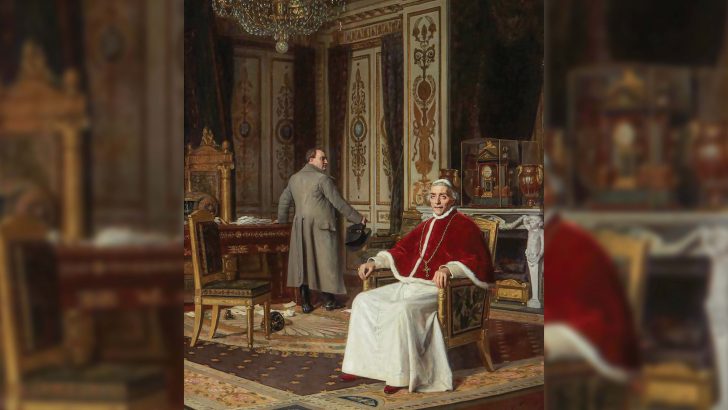To Kidnap a Pope: Napoleon and Pius VII
by Ambrogio A. Caini (New Haven and London: Yale University Press, £ 20.00 / €24.00)
Frank Litton
Of all the themes in European history, the relationship between Church and state, religion and politics, has had the greatest impact in making Europe what it is. With the French Revolution, European history turned in a new direction.
Ambrogio A. Cainini’s account of the interactions between Napoleon and Pius VII traces how their efforts to remake the relationship between Church and state lead to a papacy with increased effective authority and a sharper distinction between Church and state.
Intention
This was not Napoleon’s intention. On the contrary he worked hard for a Church subservient to the state, with the Pope a mere figure head. It is a fascinating story, well-told based on research in the Vatican archives historians had left previously unvisited.
The state needs the Church, the Church needs the state. The state needed the Church to underpin its legitimacy providing it with a sacred aura that enhanced its authority. The Church needs the state’s laws to secure its institutions and give it the space to pursue its mission. If interests converge they can also conflict as the aftermath of the French revolution illustrates.
The revolutionaries went about recasting the relationship between Church and state. The atmosphere was hostile to both the Church and its teaching. The French episcopacy had been well-integrated into the upper echelons of the aristocratic order that the revolution was dismantling. The Enlightenment taught the revolutionaries that Church doctrine was baseless superstition crafted to enslave the ignorant.
When efforts to concoct a secular religion that would sacralise the state failed the next step was to take over the Church, confiscate its properties, turn its clergy into state officials and appoint its bishops. This state-sponsored Church was under the control of a ‘minister of religion’.
While many of the lower clergy and their flock had little reason to support the ancien regime and could have been co-opted into the Republic, these proposals went too far. They provoked considerable resistance that was put down with many deaths and much bloodshed.
The outcome satisfied neither Church nor state. The Church was divided and weakened. Some bishops and priests, more or less reluctantly, join the state Church, many refused and were dismissed from their parishes. The state did not receive the benediction that would have strengthened its authority. Indeed its actions increased the opposition.
Context
This was the context in which Pius and Napoleon manoeuvred to reset the relationship and find a balance among their competing interests.
Pius was not a defender of the ancien regime. He believed that democracy was compatible with Christianity. Indeed the equality of all in the eyes of God supported it. Napoleon recognised the contribution of religion to the well-ordering of society and political stability. Both found the situation in France intolerable. There was a basis for agreement.
Cainani traces the twists and turns of the negotiations with skill. He combines the personalities and the issues in a narrative that keeps the reader reading, anxious to know what happened next.
What happened was a concordat signed in 1801. Both parties made concessions. The Church had to give up its claim to be recognised as the ‘one true faith’ with the authority that followed and accepted acknowledgment as ‘the faith of the majority of the French’. Napoleon had to concede the Pope’s final authority in the appointment of bishops.
Coronation
The rapprochement was marked by the Pope’s attendance at Napoleon’s coronation as emperor in 1804. The complexities of the concordat were manifested in the choreography of the event.
This was not the end of the story. Pius believed, as most did that the Pope’s authority as head of the universal Church required his independence of all political authority. This could only be secured if the Pope himself was a head of state. The papacy could not function without the papal states.
Napoleon cast himself in the role of a second Charlemagne and his imperial ambitions could not accept independent papal states. The imperial army invaded Rome. The Pope refused to surrender his sovereignty and submit to the emperor. Five years of imprisonment in France followed, when Pius, isolated from his followers was bullied by Napoleon and his agents. Despite the psychological pressures and physical illness, Pius did not submit.
This well told story casts a perspective on Church-state relations quite different from the limited perspective dominant in present-day Ireland.


 Pius VII resisting the demand of the Emperor Napoleon, from a painting by Joseph Frapaa
Pius VII resisting the demand of the Emperor Napoleon, from a painting by Joseph Frapaa 
